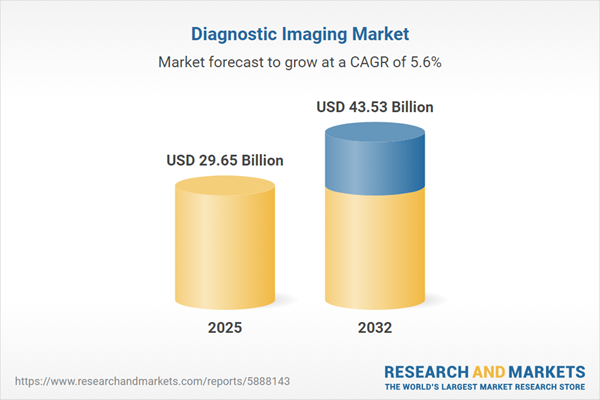Speak directly to the analyst to clarify any post sales queries you may have.
Diagnostic imaging is rapidly evolving as healthcare systems worldwide prioritize efficiency, accuracy, and integrated care delivery. Innovations in hardware and software, combined with shifting operational models and regulatory adjustments, are redefining both the opportunities and challenges facing senior leaders in this dynamic market.
Market Snapshot: Growth Trajectory and Key Drivers
The diagnostic imaging market grew from USD 28.07 billion in 2024 to USD 29.65 billion in 2025 and is projected to reach USD 43.53 billion by 2032, reflecting a CAGR of 5.63%. Sustained demand for advanced modalities, the adoption of artificial intelligence (AI), and evolving clinical needs underpin this robust growth. Factors such as rising disease prevalence, expanding outpatient services, and the shift towards value-based healthcare models continue to drive strategic investments and technology adoption.
Scope & Segmentation Overview
- Modality: Computed tomography (cone beam, conventional, portable), magnetic resonance imaging (high-field, low-field, ultra-high-field), nuclear medicine (positron emission tomography, single photon emission computed tomography), ultrasound (2D, 3D, 4D, Doppler), and X-ray (computed radiography, digital radiography)
- Component: Hardware (coils, detectors, generators, transducers), services (consulting, installation, maintenance, training), and software (AI analytics, PACS, reporting software, RIS)
- End User: Clinics, diagnostic centers, hospitals, research institutes
- Application: Cardiology, dental, neurology, obstetrics/gynecology, oncology, ophthalmology, orthopedics
- Technology Type: 2D imaging, 3D imaging, 4D imaging
- Regions: Americas (United States, Canada, Mexico, Brazil, Argentina, Chile, Colombia, Peru), Europe Middle East & Africa (UK, Germany, France, Russia, Italy, Spain, Netherlands, Sweden, Poland, Switzerland, UAE, Saudi Arabia, Qatar, Turkey, Israel, South Africa, Nigeria, Egypt, Kenya), Asia-Pacific (China, India, Japan, Australia, South Korea, Indonesia, Thailand, Malaysia, Singapore, Taiwan)
- Companies Covered: GE HealthCare Technologies, Siemens Healthineers, Koninklijke Philips, Canon Medical Systems, Fujifilm Holdings, Samsung Medison, Mindray Medical International, Shimadzu Corporation, Hitachi, Hologic
Key Takeaways for Senior Decision-Makers
- The integration of AI analytics is expediting diagnostic accuracy, reshaping imaging workflows, and enabling real-time, data-driven decision-making across diverse care settings.
- Cloud-native communication systems and digital connectivity are optimizing collaboration among providers, while robust interoperability is streamlining clinical information flow.
- Modular hardware and subscription-based software models are reducing capital risks, allowing providers to upgrade incrementally and maintain technological currency without large-scale replacements.
- Segment-specific demand is rising for point-of-care imaging in outpatient and emergency settings, driven by patient-centric models and reduced hospital dependency.
- Strategic alliances between equipment manufacturers and software developers are accelerating time-to-market for integrated, innovative solutions tailored to varied end users.
- Lifecycle sustainability, including remanufactured components and energy-efficient design, is gaining attention as providers and vendors align with value-based and responsible care objectives.
Impact of U.S. Tariff Policies on the Diagnostic Imaging Market
Forthcoming U.S. tariffs are driving manufacturers to reconsider sourcing and supply chain strategies for key hardware. Many organizations are shifting to suppliers in tariff-exempt regions or relocating assembly operations, aiming to mitigate cost variability and minimize service interruptions. This realignment is influencing maintenance agreements and pushing adoption of predictive maintenance technologies, helping providers sustain operational performance even as import costs and lead times shift. Capital planning is increasingly favoring modular solutions, enabling upgrades and adaptation without widespread asset replacement.
Methodology & Data Sources
This analysis utilizes a comprehensive methodology, encompassing executive interviews, sector expert panels, and rigorous secondary research through journals, filings, and patent reviews. Data triangulation and multi-stage validation assure accuracy and relevance for strategic decision-making.
Why This Report Matters
- Enables executive leaders to make informed investment decisions in a complex and rapidly changing diagnostic imaging landscape.
- Offers actionable insights to strengthen operational resilience, optimize technology adoption, and reduce exposure to supply chain and policy risks.
- Equips stakeholders to identify growth opportunities through regional trends, segmentation analysis, and competitive benchmarking.
Conclusion
The diagnostic imaging market is defined by technological convergence, evolving care delivery models, and dynamic policy influences. Leaders who prioritize modularity, digital integration, and collaborative innovation are best positioned for future-ready, patient-centric growth.
Additional Product Information:
- Purchase of this report includes 1 year online access with quarterly updates.
- This report can be updated on request. Please contact our Customer Experience team using the Ask a Question widget on our website.
Table of Contents
3. Executive Summary
4. Market Overview
7. Cumulative Impact of Artificial Intelligence 2025
Companies Mentioned
The companies profiled in this Diagnostic Imaging market report include:- GE HealthCare Technologies, Inc.
- Siemens Healthineers AG
- Koninklijke Philips N.V.
- Canon Medical Systems Corporation
- Fujifilm Holdings Corporation
- Samsung Medison Co., Ltd.
- Mindray Medical International Limited
- Shimadzu Corporation
- Hitachi, Ltd.
- Hologic, Inc.
Table Information
| Report Attribute | Details |
|---|---|
| No. of Pages | 195 |
| Published | October 2025 |
| Forecast Period | 2025 - 2032 |
| Estimated Market Value ( USD | $ 29.65 Billion |
| Forecasted Market Value ( USD | $ 43.53 Billion |
| Compound Annual Growth Rate | 5.6% |
| Regions Covered | Global |
| No. of Companies Mentioned | 11 |









